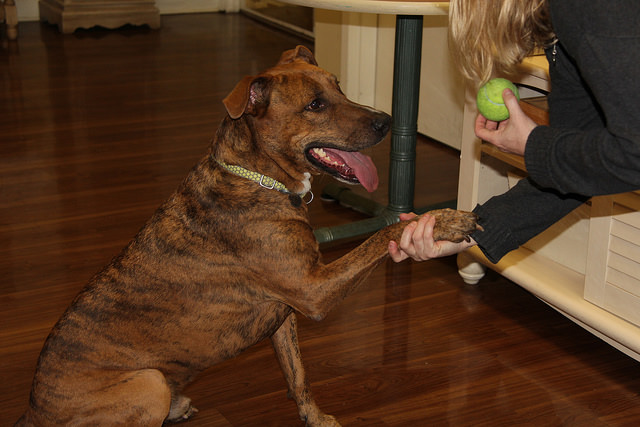Your shoes are safer around a senior dog than they are a puppy, and most older dogs have long-since mastered basic obedience. But that doesn’t mean training is no longer important. Old age doesn’t stop a dog from learning new tricks, and continued training is a big part of maintaining mental and physical health. There’s also the fact that senior dogs aren’t perfect, and training can help fend off problem behaviors.
Whether you’ve loved your dog since they were a pup or recently adopted them from a shelter, here’s what to know about training a senior dog.

Assess Their Training History
If your dog has spent their entire life by your side, assessing where they are with training is easy. It’s more complicated for families that recently adopted a senior from a shelter. Your newly adopted dog’s past life is probably a complete mystery, and you don’t know what kind of training they’ve already received. To make sure your training is as worthwhile as it should be, take time to get to know your new friend.
Spend your first few days evaluating what level of training they’re on. Test them by saying things like “sit” and “lay down” and observing how they react. Some older rescues go to new homes already knowing a lot, but for others, simple things like wearing a leash are brand new. Once you have an idea of what your dog already knows, you can move forward based on their previous experiences.
Consider Physical Limitations
As dogs age, they start to slow down. Their joints become stiff and their hearts have to work a little harder to keep blood pumping. Many suffer from arthritis, obesity, and other health conditions related to old age. Physically demanding activities, like agility and dock jumping, are no longer safe for some seniors. Before you start a new training regimen, consider your dog’s physical limitations. AKC says,
“Be sure to take your dog’s physical and mental abilities into consideration when choosing what to train. If he is suffering from arthritis, for example, teaching him to beg or jump the high bar may not be the best choice. Be realistic about what his mind and body can handle.”
Every dog is different, and it’s a good idea to talk to your vet before moving forward with training. You never want to ask your dog to do something that puts their health or well-being at risk.

Learn About Positive Reinforcement Training
Positive reinforcement training is a method that uses things like praise and food to reinforce desired behavior. When your dog does something good, you give them a reward. When they do something “bad” or fail to follow a command, you ignore them. The reward they receive for doing something good encourages them to perform that particular behavior again. This training method has taken over as the preferred strategy for both professional dog trainers and dog owners. It’s replacing punishment-based training methods and has been proven to be one of the most effective ways to train a dog regardless of their age. Whole Dog Journal writes,
“There is overwhelming anecdotal evidence that dogs trained with positive methods are quite willing to keep on learning—while those trained with physical and/or verbal punishment are more likely to shut down and less willing to offer new behaviors.”
Senior dogs are especially responsive to positive reinforcement training, and it’s a good way to strengthen both your bond and your dog’s interest in learning new skills.
Use Verbal and Visual Cues
You can’t expect your dog to do what you want if they can’t understand what you’re asking. Your cues need to be easily recognized and understood. The best way to do that is to use both verbal and visual cues. Many senior dogs end up losing their hearing and/or vision, and by teaching both a verbal and visual cue, you cover all your bases in case one of your dog’s senses starts failing in the future.
For example, when you teach your senior dog the command to heel, use both a word and a hand signal. Say the word “heel” at the same time you use your hand to tap your hip. If your dog loses both their hearing and eyesight, learn more about how to train with touch commands.

Take Frequent Breaks
Old dogs don’t have the stamina they used to. They get tired easily, and long training sessions can be too much for them. Depending on what you’re doing, repeated actions—like rolling over 10 times in a row—can end up hurting them. If this happens, your dog will be reluctant to continue, and you’ll both end up frustrated.
It’s best to keep your training sessions short and sweet. Only go for a few minutes at a time and give your pooch plenty of down time in between. If you notice signs of them becoming physically or mentally tired, don’t push them to keep going. You can pick up where you left off in a few hours or the next day.
Practice Patience
The belief that old dogs can’t learn new tricks has long-since been proven false. They are, however, at a slight disadvantage compared to puppies. Puppies go through developmental stages where their brains are specifically wired to take in new information. They’re primed with a blank slate and have plenty of energy and enthusiasm. Older dogs are past that stage in their lives, and decreased cognitive function is a common side effect of old age. As long as they’re generally healthy, however, they shouldn’t have a problem learning new skills. They’ll need your patience and commitment, but with the right strategy, they’ll be happy to work with you on continued training.
It doesn’t matter whether your dog is 12 weeks or 12 years old, training is an important part of their life. It keeps their mind working and their body moving, and it also offers an opportunity for man and man’s best friend to spend quality time together. Training your senior dog isn’t much different than training a puppy, but it’s still important to consider their specific needs. Don’t push them too hard and be patient while they learn new skills. If you do it right, it will be a positive experience for the both of you.
Featured image via Flickr/Eli Christman
